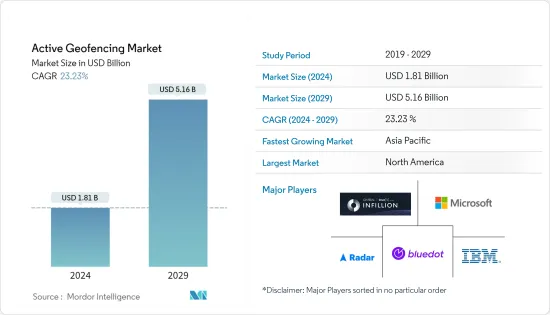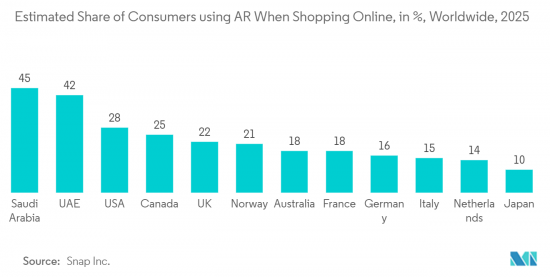 |
市場調查報告書
商品編碼
1404327
主動地理圍籬:市場佔有率分析、產業趨勢與統計資料、2024 年至 2029 年的成長預測Active Geofencing - Market Share Analysis, Industry Trends & Statistics, Growth Forecasts 2024 - 2029 |
||||||
※ 本網頁內容可能與最新版本有所差異。詳細情況請與我們聯繫。
預計主動地理圍籬市場規模到 2024 年將達到 18.1 億美元,預計到 2029 年將達到 51.6 億美元,在預測期內(2024-2029 年)複合年成長率為 23.23%。

由於空間資料的更有效利用、即時資訊技術的改進以及全球消費者擴大採用基於位置的應用程式,主動地理圍欄正在不斷發展。
主要亮點
- 地理圍欄是一種應用程式或應用程式,當設備離開稱為地理圍欄的地理區域的虛擬邊界時,利用 GPS、PFID、WiFI 和移動資料等技術觸發預編程操作。它是軟體,是一種定位是基於每個最終用戶使用的服務。
- 空間資料和即時資訊技術的使用不斷增加,正在改變人們和企業與世界互動的方式,並節省數百萬人的開支。各種設備和系統都連接到網際網路,包括電話、智慧建築、汽車導航系統、工業和自動駕駛汽車。需要提供即時位置資訊的技術來維持系統的日常正常運作。
- 由於技術彈性和功能,主動地理圍欄的進步正在不斷增加。市場成長將受到數位行銷、叢集、自動駕駛汽車和自帶設備等趨勢的推動。因此,預計所研究的市場將保持強勁,市場參與企業將做出顯著的成長貢獻。
- 關於位置追蹤的日益關注和法規可能會威脅到主動地理圍欄技術。此外,由於各地區缺乏處理隱私和資料收集的監管機構,主動地理圍欄解決方案也受到阻礙。
- COVID-19 病毒增加了主動地理圍籬在醫學、工業等多個領域的使用。例如,每家公司都必須提交一份申請,以識別其場所內的員工身份,並立即直接與他們聯繫。主動地理圍籬有助於在緊急情況下安全、及時地通訊。
主動地理圍籬市場趨勢
零售部門確認顯著成長
- 主動地理圍欄允許零售商識別特定銷售點周圍指定半徑內的潛在客戶,向他們發送客製化訊息和特別優惠,以幫助他們進入商店和購買。此外,隨著數位化繼續在零售業的各個領域蔓延,零售業對有效地理圍欄的需求正在迅速增加。
- 利用地理圍籬資料的廣告宣傳往往會獲得更高的支出回報,因為零售商可以針對最有可能接觸其服務或產品的消費者。因此,零售企業的利潤增加。
- 此外,未來,主動地理圍欄將與先進技術和擴增實境(AR)相結合,因此客戶可以期待更加數位化和個人化的購物體驗。隨著越來越多的行動裝置成為穿戴式設備,客戶期望獲得更數位化和個人化的購物體驗。因此,我們預計在下一個預測期內,零售業將更多地採用主動地理圍欄。此外,在預測期內,零售業主動地理圍籬市場的成長前景預計將受到零售商擴大採用促銷其優惠和廣告的推動。
- 換句話說,根據Snap公司最近分析的趨勢,預計近三分之一的美國消費者將在兩年內使用AR技術透過網路購買商品,並將定義購物的未來。網路購物時,您可以使用擴增實境 (AR) 技術虛擬檢視產品。報告顯示,歐洲的 AR 使用率高達 45%,但在阿拉伯聯合大公國等國家則較低。零售業的擴增實境可能會為這個研究市場創造成長機會。

北美預計將佔據主要市場佔有率
- 北美在醫療保健、交通、物流、金融服務部門和安全等各個端點上都出現了積極的地理圍欄投資和創新。在該地區,空間資訊和即時資訊技術的整合正在推動市場發展。
- 此外,該地區主要由來自 BFSI 行業、零售、運輸和物流行業的公司主導,這些公司可以使用主動地理圍欄。此外,北美是世界上最新興經濟體的所在地:美國和加拿大。由於該地區強大的通訊和網際網路基礎設施,該地區也處於市場領先地位。
- 此外,數位技術的廣泛部署以及每個企業對商業智慧工具的需求不斷增加,導致擴大採用採用各種地理圍欄解決方案的自動化工具。
- 然而,許多本地零售商擴大透過數位優惠和促銷活動積極應用地理圍欄,以增強客戶忠誠度。零售商還可以更好地了解顧客在訪問特定商店之前和之後來自哪裡。
主動地理圍籬產業概述
由於 Bluedot Innovation Pty Ltd、Infillion Inc. (GIMBLE)、IBM Corporation、Microsoft Corporation、Radar Labs Inc. 等知名供應商的參與,主動地理圍籬市場適度分散。主要企業參與收購和合作等各種策略,以提高市場佔有率並提高所研究市場的盈利。
2023 年 7 月,Radar 宣布與 Cordial 建立合作夥伴關係,透過基於定位的體驗(例如本地應用程式模式、商店地圖和定位器以及地址自動完成)來提高參與度和收益。透過將 Radar 業界領先的資訊基礎設施與 Cordial 的行銷和資料平台相結合,JOANN 等品牌可以即時為其客戶提供高度個人化、與環境相關的體驗。
2022年9月,M3宣布其專有勞動力管理軟體「M3 Labor」的重大演變,該軟體由地理圍欄和信標技術組成。這項新功能讓M3勞工服務用戶設定員工上下班打卡的半徑。這些新功能可以讓飯店員工在需要的時間和地點打卡和簽退,同時防止他們在其他地點打卡和簽退,避免了錯誤簽到或簽到的可能性。
其他福利:
- Excel 格式的市場預測 (ME) 表
- 3 個月的分析師支持
目錄
第1章簡介
- 研究假設和市場定義
- 調查範圍
第2章調查方法
第3章執行摘要
第4章市場洞察
- 市場概況
- 產業吸引力-波特五力分析
- 供應商的議價能力
- 買方議價能力
- 新進入者的威脅
- 替代品的威脅
- 競爭公司之間的敵對關係
- 產業價值鏈分析
- COVID-19 對市場的影響
第5章市場動態
- 市場促進因素
- 增加空間資料的使用和即時資訊技術的改進
- 消費者中位置資訊使用的滲透率
- 市場抑制因素
- 提高消費者對位置資訊追蹤的安全意識
第6章市場區隔
- 按組織規模
- 中小型企業
- 大型企業
- 按最終用戶產業
- 銀行、金融服務和保險
- 零售
- 國防、政府、軍隊
- 醫療保健
- 製造業
- 運輸/物流
- 其他最終用戶產業
- 按地區
- 北美洲
- 歐洲
- 亞太地區
- 拉丁美洲
- 中東/非洲
第7章競爭形勢
- 公司簡介
- Bluedot Innovation Pty Ltd
- Infillion Inc.(GIMBLE)
- IBM Corporation
- Microsoft Corporation
- Radar Labs Inc.
- Google LLC
- Samsung Electronics Co.
- Verve Inc.
- Apple Inc.
- LocationSmart
- SZ DJI Technology Co.
- ESRI
第8章投資分析
第9章市場的未來

The Active Geofencing Market size is estimated at USD 1.81 billion in 2024, and is expected to reach USD 5.16 billion by 2029, growing at a CAGR of 23.23% during the forecast period (2024-2029).
Active geofencing is growing due to more effective use of Spatial Data, improving Real Time Location Technologies, and increased adoption worldwide for location-bassed applications by consumers.
Key Highlights
- Geofencing is a location-based service used by each end user, for which an application or software uses technologies such as GPS, PFID, WiFI, and mobile data to enable them to trigger preprogrammed actions when the device leaves virtual boundaries of geographical zones known as geofences.
- How people and businesses interact with the world and make huge savings has changed due to the increased use of spatial data and real-time location technologies. All kinds of devices and systems are connected to the Internet, such as phones, Smart buildings, car navigation systems, industries, or fleets of autonomous vehicles. Technology that provides real-time location data is required to maintain the system's proper functioning on a daily basis.
- With technological flexibility and capabilities, advancement in Active Geofencing is increasing. The market's growth is driven by trends such as digital marketing and clustering, autonomous cars, increased adoption of Bring Your Own Device, etc. The market studied, therefore, is expected to remain robust and will have a significant growth contribution from players in the market.
- Increasing concerns and regulations regarding location tracking can threaten active geofencing technologies. Moreover, active geofencing solutions are being held back due to the lack of regulatory bodies dealing with privacy and data collection in various regions.
- The COVID-19 virus increased the use of Active Geofences in several sectors, such as healthcare, industry, and many others. For example, an application had to be submitted by individual companies to identify staff at their premises and communicate with them directly and immediately. Active geofencing has facilitated secure, timely communication during an emergency.
Active Geofencing Market Trends
Retail Segment to Witness Significant Growth
- Active geofencing allows retailers to identify potential customers within a specified radius around a particular point of sale, sending them customized messages and special offers to walk into the store and buy. Moreover, demand for effective geofencing is increasing rapidly in the retail sector as digitization continues to spread across all sectors of retailing.
- The advertising campaigns using geofenced data tend to deliver a higher return on expenditure due to their ability for retailers to target consumers who are at the highest risk of engaging with their services or products. Thus, the profits of retail organizations are increased.
- Moreover, In the future, active geofencing combined with advanced technologies and augmented reality (AR), customers expect a more digital-first, personalized shopping experience. Customers expect a more digital-first, personalized shopping experience as more mobile devices become wearables. This will lead to increased uptake of active geofencing in retail during the coming forecast period. Moreover, the prospects for growth of the Active Geofencing Market in the Retail Industry over the forecast period are expected to be driven by increasing adoption between retailers regarding promoting their offers and advertising.
- In other words, almost a third of US consumers are expected to use AR technology to purchase goods on the Internet in two years, based on Snap Inc.'s recently analyzed trends, which will define the future of shopping over two years. Virtual browsing of products is possible using Augmented Reality technologies when shopping online. According to the report, while the predicted use of AR was as high as 45% in Europe, this was much lower in countries such as the United Arab Emirates. Augmented Reality in retail could provide a growth opportunity for this study market.

North America is Expected to Hold the Major Share of the Market
- In North America, active geofencing investments and innovation have been made at various endpoints, such as healthcare, transport, logistics, financial services sector, security, and many others. Market forces push for integrating spatial information and real-time location technologies in this region.
- Further, this region is dominated by companies in the BFSI sector, retail and transport, and logistics sectors capable of using active geofencing. In addition, North America has one of the most developed economies in the world in the form of the United States and Canada. As a result of the strong communication and Internet infrastructure in the region, it is also leading the market.
- In addition, the adoption of automated tools that take different geofence solutions has increased due to the wide deployment of digital technologies and the growing demand for business intelligence tools in all kinds of enterprises.
- However, many regional retailers are increasingly applying active geofencing through digital offers and promotions to strengthen customer loyalty. Retailers can also better understand where their customers are coming from before and after they visit one particular shop.
Active Geofencing Industry Overview
The active geofencing Market is moderately fragmented due to prominent vendors like Bluedot Innovation Pty Ltd, Infillion Inc. (GIMBLE), IBM Corporation, Microsoft Corporation, Radar Labs Inc., etc. The key players are involved in various strategies, such as acquisitions and partnerships, to improve their market share and enhance their profitability in the market studied.
In July 2023, Radar announced our partnership with Cordial, Increasing engagement and revenue through location-based experiences like on-premise app modes, store maps and locators, and address autocomplete. By combining Radar's industry-leading location infrastructure with Cordial's marketing and data platform, brands like JOANN deliver highly personalized, contextually relevant experiences to their customers in real-time.
In September 2022, M3 announced significant advancements to its proprietary Labour Management software, M3 labor, consisting of geofencing and beacon technologies. With this new functionality, users of the M3 Labour service can create an area radius where staff can punch in and out at work. These new features are intended to ensure that hotel staff clock in and out when and where they should while preventing them from doing so elsewhere, thereby avoiding the possibility of false and erroneous punching.
Additional Benefits:
- The market estimate (ME) sheet in Excel format
- 3 months of analyst support
TABLE OF CONTENTS
1 INTRODUCTION
- 1.1 Study Assumptions and Market Definition
- 1.2 Scope of the Study
2 RESEARCH METHODOLOGY
3 EXECUTIVE SUMMARY
4 MARKET INSIGHTS
- 4.1 Market Overview
- 4.2 Industry Attractiveness - Porter's Five Forces Analysis
- 4.2.1 Bargaining Power of Suppliers
- 4.2.2 Bargaining Power of Buyers
- 4.2.3 Threat Of New Entrants
- 4.2.4 Threat of Substitute Products
- 4.2.5 Intensity of Competitive Rivalry
- 4.3 Industry Value Chain Analysis
- 4.4 Impact of COVID-19 on the Market
5 MARKET DYNAMICS
- 5.1 Market Drivers
- 5.1.1 Increased Use of Spatial Data and Improved Real-time Location Technology
- 5.1.2 Higher Adoption of Location-based Application among Consumers
- 5.2 Market Restraints
- 5.2.1 Rising Awareness Regarding Safety and Security among Consumers of Location Tracking
6 MARKET SEGMENTATION
- 6.1 By Organization Size
- 6.1.1 Small-Scale and Medium-Scale Businesses
- 6.1.2 Large-Scale Businesses
- 6.2 By End-user Industry
- 6.2.1 Banking, Financial Services, and Insurance
- 6.2.2 Retail
- 6.2.3 Defense, Government, and Military
- 6.2.4 Healthcare
- 6.2.5 Industrial Manufacturing
- 6.2.6 Transportation and Logistics
- 6.2.7 Other End-user Industries
- 6.3 By Geography
- 6.3.1 North America
- 6.3.2 Europe
- 6.3.3 Asia Pacific
- 6.3.4 Latin America
- 6.3.5 Middle East and Africa
7 COMPETITIVE LANDSCAPE
- 7.1 Company Profiles
- 7.1.1 Bluedot Innovation Pty Ltd
- 7.1.2 Infillion Inc. (GIMBLE)
- 7.1.3 IBM Corporation
- 7.1.4 Microsoft Corporation
- 7.1.5 Radar Labs Inc.
- 7.1.6 Google LLC
- 7.1.7 Samsung Electronics Co.
- 7.1.8 Verve Inc.
- 7.1.9 Apple Inc.
- 7.1.10 LocationSmart
- 7.1.11 SZ DJI Technology Co.
- 7.1.12 ESRI










